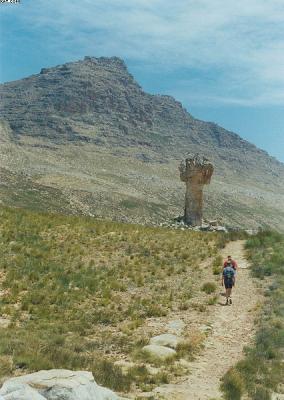

This 71 000-ha mountain complex is managed by Cape Nature Conservation principally for conservation of the pure, silt-free water of this catchment area, as a recreation area and as a sanctuary for the bio diverse Cape fynbos.
Erosional processes in the Cedarberg have fashioned a bizarre landscape highlighted by such famous natural rock sculptures as the Maltese Cross and the Wolfberg Arch.
The highest peak, Sneeuberg (2 028 m), is one of the few homes of one of the world's rarest plants, Protea cryophila, the snow protea.
Another unusual species found in the Cederberg is the Clanwilliam cedar, Widdringtonia cedarbergensis, after which the mountain range is named.
Two plants of considerable economic importance - rooibos tea (Aspalathus linear is) and round-leaved buchu (Agathosma betulma) - are also present.
Babooons, dassies, grey rhebok, klipspringers, duiker and grysbok are fairly common in ghe Cederberg. Porcupine, honeybadger, Cape clawless otter and aardvark also occur although they are seldom seen.
The leopard is the Cederbergs largest predator and is fairly common although very shy. Smaller predators include African wild cat, lynx, bat-eared fox, aardwolf and Cape fox. The small grey mongoose and striped polecat are often seen.
Various interesting rodents occur, including the spectacled dormouse.
More than 100 bird species occur here, with black eagle, rock kestrel and jackal buzzard being the most common raptors.
About 16 snake species are found in the Cederberg the most common being berg adder, puff adder and black spitting cobra. The armadillo lizard is one of the endemic reptiles found here.
Activities such as hiking and traditional rock climbing are encouraged as long as rock surfaces remain undamaged. Old woodcutters paths crisscross the Wilderness Area and hikers may explore the area at will.
An extensive network (254 km) of unmarked, well maintained footpaths are laid out, and excellent rock climbing opportunities exist.
The Wolfberg Cracks and Arch, the Maltese Cross and Sneeuberg are each the subject of a separate popular day walk from the private farms adjoining the wilderness area in the south.
Rock art
The Cederberg offers hundreds of rocky overhangs and caves with fine examples of rock art. These paintings vary in age between 300 and 6 000 years, and are very sensitive to damage. They are an integral part of the Wilderness Areas value and visitors are encouraged to discover them on their own.
The peaceful atmosphere of the Algeria campsite has broad appeal. Here, 48 sites are situated along the banks of the Rondegat River.
The Kliphuis campsite is in the Pakhuis Pass on the flower route to the Biedouw Valley and Wupperthal. This campsite has 10 spots under shady trees along the Kliphuis River.
Cape Nature
Private Bag X29
Rondebosch
7701
(021) 426 0723
(021) 423 9611

